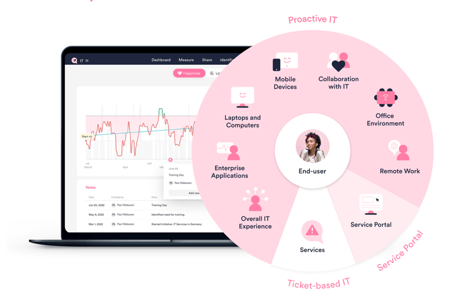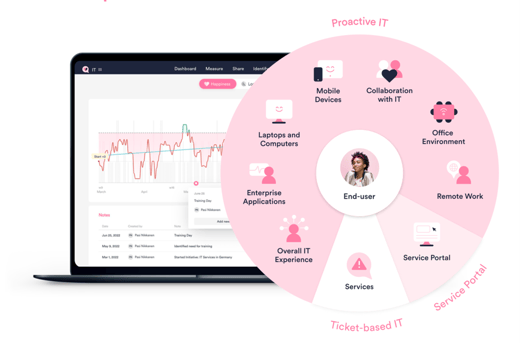Trends Driving ITXM in 2024
What will 2024 hold for IT experience management? Here, Roy Atkinson shares his thoughts.

In sports statistics, an asterisk is added to a season or a player record when there is some shift that makes comparison to previous seasons difficult. When a new kind of ball is introduced, or the season is lengthened, or the rules are changed enough to make a difference, the asterisk lets us know.
2024 will be different in many industries, including IT. Some trends that tend historically to move relatively slowly through the world of IT service management and IT support will shift due to the advent of Generative AI and its uses in these realms. While last year’s trends post spoke of so-called “macro headwinds” (economic stress), those headwinds have now either dissipated or become far less significant. Gartner predicts a 2.7% increase in enterprise IT budgets in North America and a 4.2% increase in EMEA, close to expected inflation rates.
The impact of AI
According to research by Endava, “organizations worldwide are increasing their IT and innovation budgets, signaling growth and a shift in focus from operational stability to innovation” and 81% of the leaders and decision-makers—regardless of vertical—who responded to the survey feel either optimistic (55%) or very optimistic (26%) about the economic environment.
The Endava report goes on to say, “When looking at individual technologies, unsurprisingly, one technology emerges as the undisputed champion - artificial intelligence (Al). Nearly 80% of those surveyed regarded it as either high- or very high-priority technology. Currently, interest in AI is exceptionally high, with Generative AI such as ChatGPT dominating technology discussions globally.” A new and game-changing technology at the very apogee of its “hype cycle” is bound to have significant impact on IT.
As of the end of 2023, we do not know what that impact will actually be, but here are some of the areas we think will be impacted by AI:
- Spending will slightly increase on new or augmented ITSM tools that include GenAI
- Metrics will need to be re-evaluated in light of the differences between human and AI capabilities and the shift toward innovation
- Governance and risk management will be more of a priority as Gen AI and its potential ethical and security issues become more mainstream in IT
Value is still a priority
One area where we don’t see significant change is the emphasis on IT’s alignment with business goals and the co-creation of value. As strong as the value imperative was last year, it will remain near the top of the CIO list, although the means to achieve it may again include some enhanced technology and more collaboration with CxOs outside of IT. Rather than a prevailing “Do more with less” philosophy, 2024 will bring a “Do a lot with a little more” approach. Efficiency still matters. The need to “Demonstrate the Business Value of IT” will still be very much a priority for the C-level in many companies.
Talent retention
Last year, we talked about some large waves of layoffs in big technology firms, but we don’t see that this year; we also don’t see waves of hiring. This was a topic at a recent roundtable hosted by the National CIO Review: “The discussion also underscored the importance of so-called human capital. Budgets may be increasing, but the allocation is shifting. There’s a nuanced approach where investments in technology are balanced with the need for skilled personnel to manage and leverage these tools effectively.”
With increased emphasis on AI and related fields like data analytics, we think that talent retention is going to be a key focus, and that brings us to the subject of ITXM™.
Another key benefit of ITXM is its impact on employee happiness. By prioritizing a positive experience for employees, organizations can improve employee retention rates and reduce turnover costs. – HappySignals Global IT Experience Benchmark H1/2023
We should note here that the experience measured in ITXM covers the entire range of touchpoints with IT. The areas covered in the H1/2023 Benchmark report include mobile devices, laptops and computers, enterprise applications, the office environment, remote work, and the overall IT experience, not just ticket-based interactions with the service desk and use of the service portal. Measuring new and different types of services provided by AI-enabled tools requires flexibility and an understanding of how the uses of AI affect the consumers of IT services.

As Digital Transformation continues to be an important organizational imperative across verticals, the experiences of IT consumers remain important. The question then becomes about ensuring positive experiences.
According to the H1/2023 report, 80% of lost time is still the result of 13% of tickets, which suggests that our prioritization schema may not be adequate or that prioritization is being ignored in favor of “cherry-picking” (taking the easy, fast, friendly cases first). This is certainly an area where AI can help, assigning and prioritizing tickets according to potential productivity loss and real business impact rather than by more traditional means. Those who are planning on using AI-powered tools would do well to consider this, especially since good experience measurement leads the way to improvement.
As experience management, including ITXM, becomes more widespread and important, the demand for professionals with expertise in experience measurement and management will increase. Getting training on the basics is a way for staff to skill up.
The human factor
The H1/2023 report tells us a good deal about the effect of human-to-human contact between consumers (users) and IT personnel.
- The highest Happiness Score and lowest Lost Time reported for IT incidents were both through the walk-in channel, where people bring their affected devices to IT personnel for assistance.
- Collaboration with IT has the highest Happiness Score of all 9 measurement areas.
- IT support services have a large impact—either positive or negative—on consumers’ ratings of the overall IT experience, but the service desk is not the only area that is measured by and can benefit from ITXM.
As the report says, “The fact that 58% of respondents [who gave a positive score] selected IT Support Services and 57% selected IT Personnel’s Attitude as contributing factors suggests that the performance and behavior of IT support staff play a pivotal role in end-user satisfaction. It indicates that responsive, helpful, and friendly IT support is highly valued.”
In light of this year’s immense interest in the availability and uses of Generative AI, we believe that IT leadership has to carefully assess the impacts of substituting AI tools for humans in support interactions. While pressure is always high to reduce costs, there will be a knock-on effect of the loss of highly-rated interactions and collaborations with IT if substituting technology for people is the way chosen to accomplish the reduction. Finding ways to use the powers of AI to augment and assist IT personnel might prove a better way forward.
Conclusion
There is no doubt that the rapid proliferation of AI, especially Generative AI, will have a large effect on CIO priorities for 2024. Finding new and better ways to accomplish the work of IT while enhancing business value and fueling innovation will be a large area for cooperation between IT leaders and their business unit counterparts. Maintaining and improving the positive relationships between IT consumers and IT providers and maintaining positive experiences while leveraging the powers of emerging technologies—National CIO Review’s “nuanced approach”—will be the puzzle these leaders have to solve.
Related content

18.07.2024
How Experience Management Can Help Shape AI Initiatives
The coming of Artificial Intelligence (AI) in commercially available forms is bringing about a major change in the ...
Read more >
28.11.2024
Three Ways Good ITXM Makes ITSM Better
Some mistakenly believe that organizations have not succeeded in adopting IT service management (ITSM). But that’s not ...
Read more >
